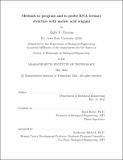Methods to program and to probe RNA tertiary structure with nucleic acid origami
Author(s)
Parsons, Molly F.
DownloadThesis PDF (207.6Mb)
Advisor
Bathe, Mark
Terms of use
Metadata
Show full item recordAbstract
Biological structure determination has revolutionized mechanistic understandings, nanotechnology, and drug design. Despite advances in structural determination technologies, from nuclear magnetic resonance to cryo-electron microscopy (cryo-EM), one class of biomolecules has resisted 3D structure characterization. RNA, particularly larger RNAs, often dynamically adopt multiple conformations in a structural ensemble, and this heterogeneity has made 3D structure determination challenging through conventional techniques.
In this thesis, I investigated two avenues for improving RNA 3D structure determination, both leveraging the nanoscale programmability of nucleic acid origami. Nucleic acid origami generally involves folding one long single-stranded nucleic acid, the scaffold, into a target geometry via hybridization with short oligonucleotide "staples." First, we expanded the geometric space accessible to 3D wireframe DNA-scaffolded origami with edges composed of two helix bundles, optimizing folding conditions and crossover design and analyzing the final folded 3D structures, for a new design algorithm. I designed a tetrahedral wireframe DNA origami to capture an engineered tRNA via hybridization at three sites. For this complex, I verified stable, cooperative binding, and characterized the 3D structure with cryo-EM, which confirmed binding at all three sites and yielded a 17-Å resolution reconstruction of the tRNA. I also outlined a high-throughput workflow to probe the unknown tertiary structure of a target RNA with varied designs of DNA origami. Additionally, I studied the design of 3D wireframe RNA-scaffolded origami, characterizing the folded structure for several crossover schemes to evaluate how best to accommodate the A-form helical geometry of RNA for robust designs. The resulting algorithm for designing RNA-scaffolded polyhedra enables precise, covalent anchoring of a target RNA fragment onto a wireframe polyhedra. I tested this anchoring approach to attach a 232-nt HIV-1 RNA fragment to an RNA-scaffolded pentagonal bipyramid as a method to improve cryo-EM characterization. The particles folded into the expected pentagonal bipyramidal geometries, and cryo-EM micrographs suggested anchored target RNA, but the design and data analysis need further refinement to determine a 3D structure for the anchored RNA fragment. These studies together represent proofs-of-concept for stabilizing RNA structures on nucleic acid origami, enabled by the expansion of origami design.
Date issued
2022-05Department
Massachusetts Institute of Technology. Department of Biological EngineeringPublisher
Massachusetts Institute of Technology